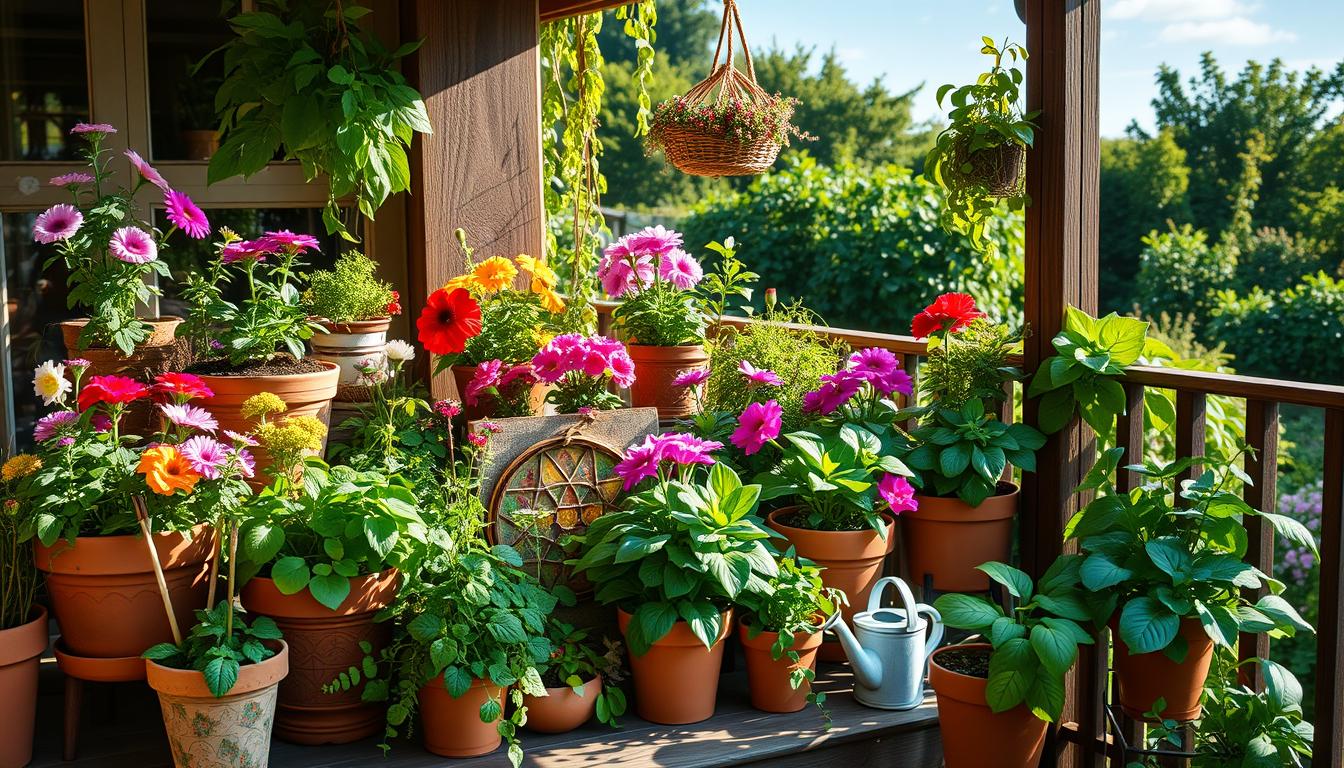I’m excited to share the basics of container gardening. It’s a great way to add greenery to your life, even with little space. You can create a thriving oasis on your patio or balcony. And enjoy the benefits of gardening in small spaces.
Container gardening tips will help you get started. I’ve learned that caring for potted plants is key to their success. By choosing the right containers, soil, and plants, you can enjoy moving plants around. This flexibility is one of the main benefits of container gardening.
In this article, I’ll share my knowledge on container gardening tips, urban gardening ideas, and potted plants care. My goal is to help you create a beautiful and thriving container garden. Whether you’re a seasoned gardener or a beginner, I’m sure you’ll find valuable information here.
Understanding Container Gardening
Container gardening is a fun way to grow plants in pots, planters, or boxes. It’s perfect for small spaces like apartments or balconies. With a few tips, you can make your balcony or patio green and lively.
Container gardening lets you control the soil and water your plants need. This is great for plants that are picky about their environment. It also makes caring for indoor plants easier, as you can move them to get the right light and water.
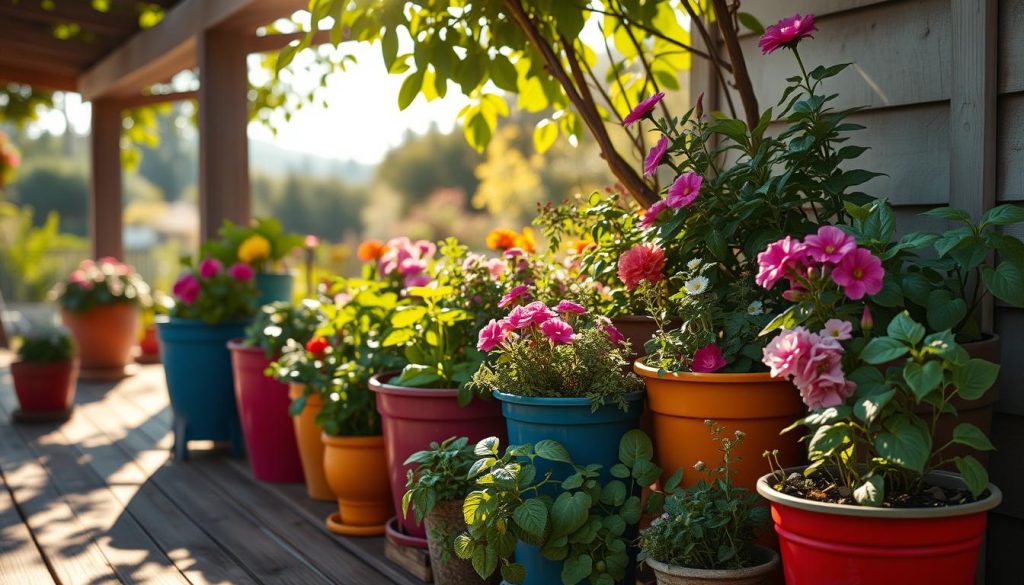
- Flexibility and mobility, making it easy to move plants around to different locations
- Control over soil and watering conditions
- Ability to grow a wide variety of plants, including herbs, flowers, and vegetables
With these tips, you can have a beautiful container garden, even in tiny spaces.
Choosing the Right Containers
When you start container gardening with vegetables, picking the right container is key. There are many creative ways to garden, but finding the perfect pot can be tough. I’ve learned that a good container should drain well and give plants enough room to grow.
It’s important to pick a container that’s big enough for the plant’s roots. A pot with holes for drainage and a mix that drains well helps avoid soggy soil and root rot. Here are some things to think about when picking a container:
- Material: You can choose from plastic, clay, wood, or metal.
- Size: Make sure the pot is big enough for the roots and has good drainage.
- Drainage: The pot should have holes to keep the soil from getting too wet.
By thinking about these points and using creative gardening ideas, you can make a great container garden. Use gardening hacks like a good potting mix and drainage to help your garden grow well.
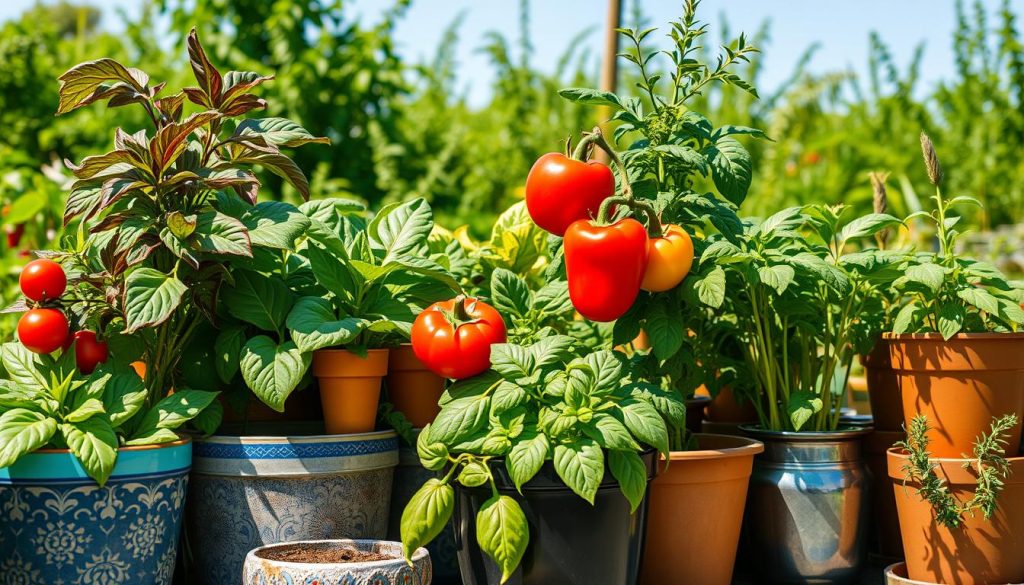
| Container Material | Advantages | Disadvantages |
|---|---|---|
| Plastic | Inexpensive, lightweight, easy to clean | May not be durable, can become brittle |
| Clay | Natural, breathable, aesthetically pleasing | Can be heavy, prone to cracking |
| Wood | Natural, durable, can be made from recycled materials | Can rot, may require maintenance |
| Metal | Durable, modern, can be made from recycled materials | Can be expensive, may rust |
Selecting the Right Soil
Choosing the right soil is key when starting a container garden. A good potting mix is vital for your plants’ health and growth. As a beginner, it’s important to know that not all soils are the same. Container gardening tips stress the need for well-draining, fertile soil made for containers.
Here are the main traits of a great potting mix:
- Well-draining to prevent waterlogged soil
- Fertile to provide essential nutrients for plant growth
- Specifically designed for containers to ensure optimal performance
It’s also crucial to tailor the soil for your plants. Different plants need different soil types, like acidic or alkaline. By picking the right soil and adjusting it for your plants, you can help them grow well. For instance, herbs might do better in slightly acidic soil to help their roots grow.
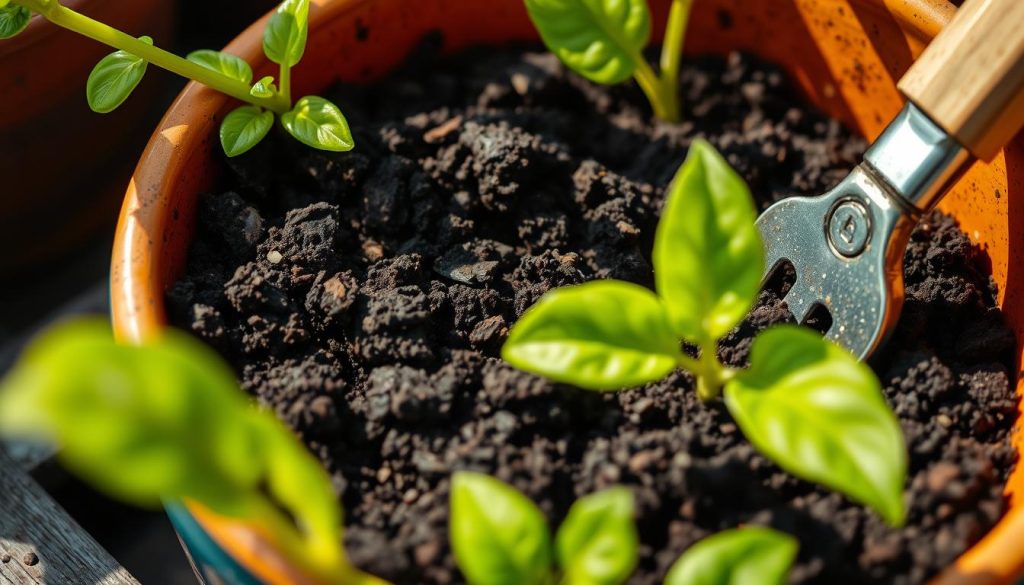
Importance of Quality Potting Mix
A quality potting mix can solve common container gardening issues like overwatering and nutrient shortages. By choosing a high-quality mix, you’re giving your plants the best chance to flourish and give you a good harvest.
Customizing Soil for Specific Plants
Whether you’re growing herbs, flowers, or veggies, it’s important to customize the soil for each plant. Look up the soil needs for each plant type and adjust your mix accordingly. With the right soil and some care, you can have a thriving container garden that adds joy and freshness to your urban gardening.
Best Plants for Container Gardening
Choosing plants for container gardening can be fun. Start with herbs like basil, mint, and rosemary. They add fresh flavor to many dishes. It’s key to pick plants that do well in pots and give them the right care.
For balcony gardening, think about flowering plants. Petunias, geraniums, and begonias add color. They’re great for indoor care, too. Here’s why:
- Herbs like basil and mint grow fast and can be ready in 6-8 weeks
- Flowers like petunias and geraniums bloom for months with care
- Vegetables like tomatoes and cucumbers give a big harvest with regular care
With these tips and care, your container garden will flourish. Even with little space, you can have a thriving garden. 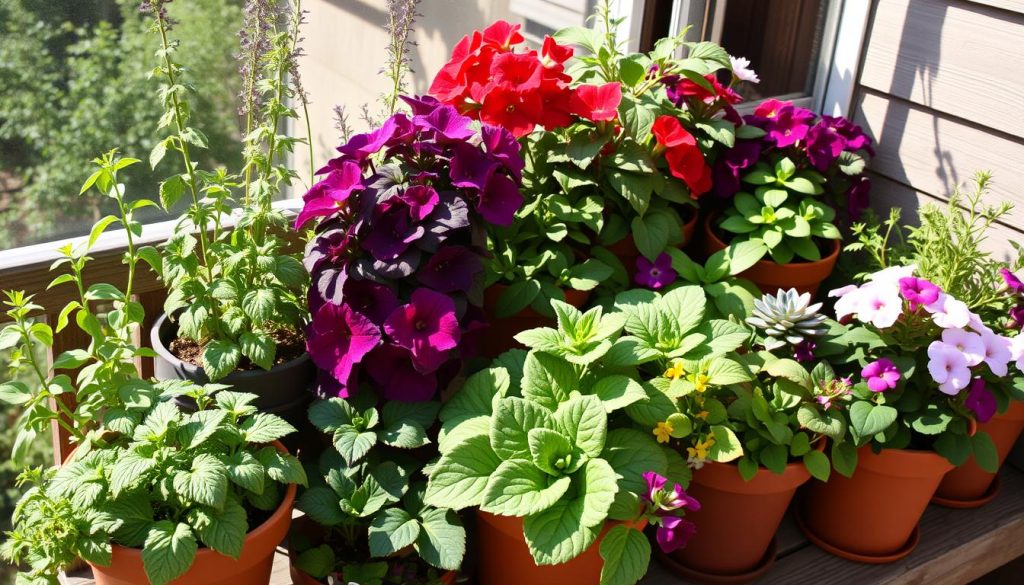
Herbs That Thrive in Pots
Rosemary, thyme, and oregano are my top picks for herbs. They’re tasty, easy to care for, and do well in pots.
Flowering Plants for Vibrant Displays
For color, try begonias, geraniums, and petunias. They’re perfect for indoor care and brighten up any space.
Vegetables Ideal for Container Growth
For a big harvest, grow tomatoes, peppers, and cucumbers. They’re great for containers and need the right care and tips.
Watering Techniques
As a small space gardening fan, I’ve found watering is key. Getting the watering schedule right for container gardening veggies is crucial. Too much water can harm plants, causing root rot. Not enough water can stress them out, making them wilt.
To avoid these issues, check the soil moisture often. Stick your finger into the soil up to the first knuckle. If it’s dry, it’s time to water. For a creative twist, use a moisture meter to make watering easier.
- Water plants in the morning to allow the soil to dry out slightly before nightfall
- Use room-temperature water to avoid shocking the roots
- Avoid getting water on the leaves to prevent fungal diseases
By following these tips and getting creative, you can create a watering schedule for your small space garden. Keep an eye on your plants and adjust your watering as needed. This ensures they get the right amount of water.
| Plant Type | Watering Frequency |
|---|---|
| Vegetables | Every 1-2 days |
| Herbs | Every 2-3 days |
| Flowers | Every 3-4 days |
Fertilizing Container Plants
Fertilizing is key for healthy growth in container gardens. The type and how often you fertilize depends on the plant and its stage. For new gardeners, start with a fertilizer made for seedlings or young plants.
Good fertilizers for containers include compost or manure tea, and synthetic options like balanced fertilizers. Always check the N-P-K ratio on the label. This shows the levels of nitrogen, phosphorus, and potassium. Here are some tips for fertilizing:
- Start with a balanced fertilizer and adjust as needed based on your plant’s response
- Use organic fertilizers whenever possible to avoid burning your plants’ roots
- Fertilize at the right time – typically when your plants are actively growing
By following these tips and choosing the right fertilizer, you can help your plants grow well. Always follow the fertilizer instructions and avoid overfertilizing. With practice and patience, you’ll become a great container gardener.
| Fertilizer Type | N-P-K Ratio | Best For |
|---|---|---|
| Compost | 1-1-1 | Seedlings and young plants |
| Balanced Fertilizer | 10-10-10 | Established plants and flowering plants |
| Manure Tea | 2-2-2 | Vegetable plants and herbs |
Managing Sunlight and Temperature
Container gardening is all about managing sunlight and temperature for plant health. It’s key to know how much sunlight your plants need. Some plants love bright, indirect light, while others can handle full sun or shade. For balcony gardening, picking the right spot for sunlight is crucial.
To keep my plants happy, I check the light in my garden and adjust. For sun-loving plants, I choose a spot with direct sunlight for 6 hours a day. Plants that prefer shade get filtered sunlight. These tips help my plants get the sunlight they need to grow well.
Here are some tips for managing sunlight and temperature in container gardening:
- Assess the light conditions in your garden and adjust plant placement accordingly
- Use shade cloth or umbrellas to filter direct sunlight
- Bring plants indoors during extreme weather conditions
By using these tips and knowing what my plants need, I create a thriving garden. Whether on a balcony or in a backyard, my plants flourish. This lets me enjoy the fruits of my labor and the benefits of gardening.
| Plant Type | Light Requirements | Temperature Requirements |
|---|---|---|
| Herbs | Bright, indirect light | 65-75°F (18-24°C) |
| Flowering Plants | Full sun to partial shade | 65-85°F (18-29°C) |
| Vegetables | Full sun | 65-75°F (18-24°C) |
Pruning and Maintenance
As a container gardener, I’ve learned that pruning and maintenance are key. Regular pruning promotes healthy growth and prevents pests and diseases. It also helps container gardening vegetables thrive.
Some important gardening hacks for pruning include removing dead or damaged leaves and stems. Cutting back overgrown branches is also crucial. This stops disease spread and encourages new growth.
Regular maintenance is vital too. This includes watering, fertilizing, and watching for pests and diseases. These steps keep my plants healthy.
Here are some key maintenance tasks to keep in mind:
- Water plants regularly, but avoid overwatering
- Fertilize plants monthly, using a balanced fertilizer
- Monitor plants for signs of pests or diseases, and take action promptly if necessary
By following these tips and using creative gardening solutions, I keep my container gardening vegetables healthy. With practice and patience, anyone can become a skilled container gardener. They can enjoy growing their own food.
Remember, pruning and maintenance are ongoing. They need regular attention and care. By staying on top of these tasks, you can enjoy a bountiful harvest and beautiful, thriving plants all season long.
| Task | Frequency | Importance |
|---|---|---|
| Pruning | Weekly | High |
| Watering | Daily | High |
| Fertilizing | Monthly | Medium |
Dealing with Pests and Diseases
Container gardening is a fun hobby, but pests and diseases can be a big problem. To keep your garden safe, check your plants often and use natural pest control. Starting a container garden means thinking about these issues to keep your plants healthy.
Aphids, whiteflies, and spider mites are common pests. To stop them, try introducing helpful bugs and use neem oil. For city gardens, use fine mesh to keep pests away.
Prevention Methods
- Inspect plants regularly for signs of pests or diseases
- Use organic pest control methods, such as neem oil or insecticidal soap
- Introduce beneficial insects, like ladybugs, to control pest populations
By using these tips, you can keep pests and diseases away. Always watch your plants and act fast if you see any problems.
Treatment Solutions
| Pest/Disease | Treatment Solution |
|---|---|
| Aphids | Neem oil or insecticidal soap |
| Whiteflies | Yellow sticky traps or insecticidal soap |
| Spider mites | Neem oil or horticultural oil |
When starting a container garden, think about pests and diseases. Use these ideas and tips to grow a strong and healthy garden.
Seasonal Container Gardening Tips
Embracing the changing seasons is key to successful
small space gardening
. As the year goes on, it’s crucial to get your
indoor plant care
and balcony gardening ready for each season.
Welcoming Spring
In spring, I refresh my garden by planting new seeds and updating the soil. It’s the best time for vibrant annuals and lush greenery to bloom.
Enjoying Summer’s Warmth
In summer, I make sure my plants get enough water and nutrients. Regular watering and fertilizing keep them healthy and productive.
Embracing the Fall Harvest
When fall comes, I harvest my edible crops and get my containers ready for winter. I prune and protect my plants to keep them safe through the cold.
Weathering the Winter
In winter, my garden needs little care, but I still watch over it. Protecting it from extreme cold and giving it just enough care keeps it going until spring.
By following these seasonal
small space gardening
tips and trying out fun plant mixes, I can keep my
indoor plant care
and
balcony gardening
thriving all year.

